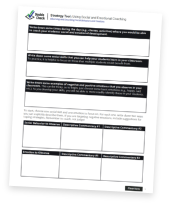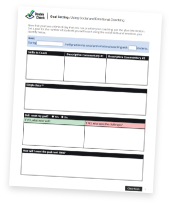Strategy: Using Social and Emotional Coaching
1) Be sure to model appropriate social skills and emotional expression/coping during interactions with your students.
2) Use subtle prompting to encourage students to perform pro-social behaviors. For example, you can ask, “Lisa, would you share your crayons with me?”
How To
A surefire way to increase your use of social and emotional coaching is to practice, practice, practice! It sounds very simple, but it can take a lot of practice to learn how to efficiently and effectively narrate the behaviors of your students if you are not normally used to doing so.
Step 1: Closely observe the expressive behaviors of your students. Observe them while they are conversing or working with peers or individually. Pay attention to what types of social behaviors (e.g., helping, sharing, turn-taking) they are exhibiting and how they express their emotions.
Step 2: Develop labels for each emotion or social interaction that you notice. For example, does a student look “calm” or “confident”? Is a student “noticing” another child’s work or “initiating” positive interactions?
Step 3: After placing a label on the emotion or social behavior, write down the reason you think a child might be feeling or acting that way (e.g., the child is excited because their homework was featured as the class highlight).
Step 4: Think of ways you can descriptively (and without judgment) communicate your observations to your student(s).
- If you are describing a positive pro-social behavior, think of ways you can explicitly praise a student for performing the behavior.
- If a behavior is not pro-social, think of ways to communicate to the student what would be appropriate behavior.
- If a student is inappropriately expressing their emotions or appears to be experiencing a negative emotion (e.g., sad, angry, disappointed), think of ways you can communicate that emotion using words and suggest simple coping strategies for the student.
- If a student is effectively managing a negative emotion, think of ways that you can communicate to them that experiencing all types of emotions is normal and OK and what being able to manage strong emotions appropriately and safely looks like.
- If you notice a positive emotion (e.g., the student appears happy or excited), think of creative vocabulary you can use to explain what you see.
If you are observing two students arguing over a crayon, you could say, “Tony, it looks like Mary was still using the red crayon to color her picture and got upset when you took it from her without asking. Maybe you could ask Mary if it is OK if you borrow it when she is finished. (Tony asks Mary politely and Mary gives him the red crayon). Tony, you did a great job of communicating that you wanted to use something she had. Mary, that was very nice of you to share with him.”
You can use the “Observing and Describing Social Behaviors and Emotions” strategy tool to help guide your coaching and get you in the habit of using descriptive language with your students.
Example Videos:
Video Prompts:
- The students in this video are working together on an activity. One student comments that others are cheating.
- Notice how the teacher recognizes the problem from across the room (see Using Active Supervision).
- Notice how she prompts the students to find the solution.
- Notice how she makes sure all the students understand the activity before leaving to help other students.
- Her use of praise following a student responding helps to get other students on task and makes it more likely that students will respond quickly in the future.
- What did you like about how this teacher used coaching to help the students solve the problem?
- What might you do differently?
- How do you see yourself using social-emotional coaching in your classroom?
Video Prompts:
- A student is concerned about a peer using his pencil.
- Notice how the teacher prompts possible solutions with a focus toward the students “doing their number one job.”
- Notice how, despite the fact that the boy does not choose to share, the teacher compliments the peer who chose to give the pencil to the boy.
- Notice how she points out that Sofia (peer) was so kind and was a good friend.
- Notice how she calmly discusses how the boy in the video could think about sharing in the future.
- What did you like about how this teacher used coaching to help the students solve the problem?
- What might you do differently?
- How do you see yourself using social-emotional coaching in your classroom?
Strategy Tool

Reflection

Goal Setting

References to Other Relevant Resources:
Webster-Stratton, C. (2012). Incredible teachers: Nurturing children’s social, emotional, and academic competence. Incredible Years.